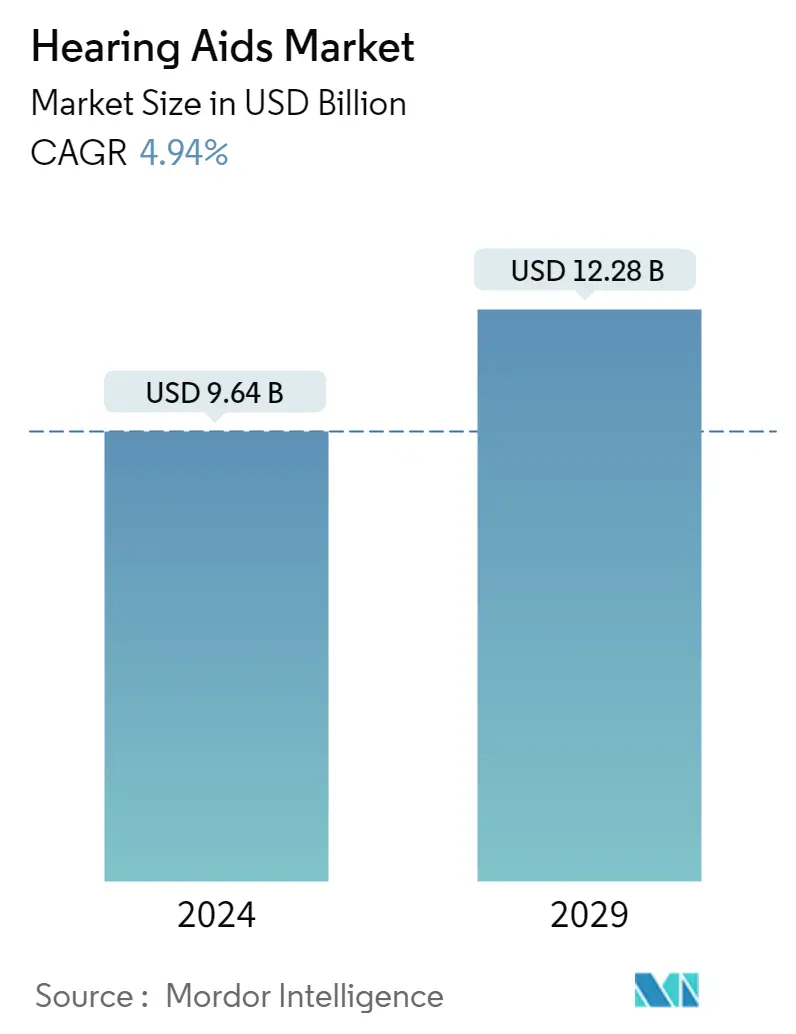Market Size of Hearing Aids Industry

| Study Period | 2019 - 2029 |
| Market Size (2024) | USD 9.64 Billion |
| Market Size (2029) | USD 12.28 Billion |
| CAGR (2024 - 2029) | 4.94 % |
| Fastest Growing Market | Asia Pacific |
| Largest Market | North America |
Major Players
*Disclaimer: Major Players sorted in no particular order |
Hearing Aids Market Analysis
The Hearing Aids Market size is estimated at USD 9.64 billion in 2024, and is expected to reach USD 12.28 billion by 2029, growing at a CAGR of 4.94% during the forecast period (2024-2029).
The COVID-19 pandemic was an unprecedented health concern that adversely affected communities, industries, businesses, and lives worldwide. COVID-19 led to disruption in the diagnostics and treatment of people with hearing problems. Due to the COVID-19 breakout, footfall in hospitals and clinics decreased during the early pandemic. For instance, according to the research study published by Europe PMC in September 2021, adult users with cochlear implants and residents of rural areas faced higher challenges during the pandemic as access to healthcare decreased drastically during the COVID-19 pandemic. However, with the decreasing cases of COVID-19, the studied market has started to gain traction and is expected to regain its full potential over the forecast period.
The major propelling factors for the growth of the hearing aid market include the rising burden of hearing loss and raising awareness and initiatives about hearing aid devices among people. For instance, according to the April 2021 report of the WHO, about 2.5 billion people are estimated to have some degree of hearing loss, and approximately 700 million people will need hearing rehabilitation by 2050. According to the same source, about 1 billion young adults risk permanent, avoidable hearing loss due to unsafe listening practices. The WHO data shows the prevalence of hearing impairment and risk worldwide. Thus, the demand for hearing aid devices is expected to increase over the years.
The rising awareness about hearing loss and hearing aid devices among the general population is further expected to act as a catalyst for the growth of the studied market. It will also increase awareness about hearing loss and the benefit of devices to people with hearing impairment. For instance, every year, the 3rd March is celebrated as World Hearing Day by the WHO and respective countries to raise awareness about hearing loss and safe listening. A special grant is provided by WHO to those who wish to do a program on these awareness programs. Hence, with the increased awareness about hearing loss, the awareness about hearing devices is also expected to improve. The studied market is anticipated to grow owing to this factor.
Growing noise pollution throughout the world also has a significant impact on the hearing abilities of people. Noise emission in heavy-duty industries, as well as public carnivals, is expected to damage the hearing capacity of adults, thereby resulting in the increasing demand for hearing aid devices. Moreover, the companies in the market are enhancing their product through technological innovation and launching new devices, which is also expected to augment the growth of the hearing aids market during the forecast period. For instance, in February 2022, Oticon announced introducing the Oticon More technologies into paediatric hearing aids. The new Oticon Play PX family are one of the world's first hearing aids for children with an onboard Deep Neural Network (DNN).
Therefore, owing to the factors above, the studied market is anticipated to witness growth over the analysis period. However, the high cost associated with hearing aids and the availability of alternative products is expected to impede the development of the market over the forecast period.
Hearing Aids Industry Segmentation
As per the scope of the report, hearing aids are sound-amplifying devices that treat hearing impairment. These devices differ by design, the technology used to achieve amplification, and special specific features. The Hearing Aids Market is segmented by product type (Behind the Ear (BTE), Receiver in the Ear (RITE)/Receiver in Canal (RIC), In the Ear (ITE), Completely-in canal (CIC), and other hearing aid devices), type of hearing loss (sensorineural hearing loss and conductive hearing loss), technology (conventional hearing aids and digital hearing aids), patient type (adults and paediatrics/children), and Geography (North America, Europe, Asia-Pacific, Middle East and Africa, and South America). The market report also covers the estimated market sizes and trends for 17 countries across major regions globally. The report offers the value in (USD million) for the above segments.
| Product Type | |
| Behind the Ear (BTE) | |
| Receiver in the Ear (RITE)/ Receiver in Canal (RIC) | |
| In the Ear (ITE) | |
| Completely-in canal (CIC) | |
| Other Hearing Aid Devices |
| Type of Hearing Loss | |
| Sensorineural Hearing Loss | |
| Conductive Hearing Loss |
| Technology | |
| Conventional Hearing Aids | |
| Digital Hearing Aids |
| Patient Type | |
| Adults | |
| Pediatrics/Children |
| Geography | ||||||||
| ||||||||
| ||||||||
| ||||||||
| ||||||||
|
Hearing Aids Market Size Summary
The hearing aids market is poised for significant growth over the forecast period, driven by an increasing prevalence of hearing loss and heightened awareness about the benefits of hearing aid devices. The market is recovering from the disruptions caused by the COVID-19 pandemic, which had initially led to decreased access to healthcare services for individuals with hearing impairments. As awareness campaigns, such as World Hearing Day, continue to educate the public on hearing loss and safe listening practices, the demand for hearing aids is expected to rise. Additionally, the impact of global noise pollution on hearing abilities is contributing to the growing need for these devices. Technological advancements and product innovations, such as Oticon's introduction of Deep Neural Network technologies in pediatric hearing aids, are further propelling market growth.
The Behind-the-Ear (BTE) segment is anticipated to hold a significant share of the market due to its amplification power, directional microphones, and user-friendly design. This segment's growth is supported by technological advancements and new product launches, such as Unitron's Stride Blu BTE hearing aids. North America is expected to maintain a substantial market share, driven by the high prevalence of hearing loss and robust healthcare infrastructure in the region. The United States, in particular, is witnessing notable growth due to the high incidence of hearing loss and increased adoption of hearing aids. The market is moderately fragmented, with key players focusing on product portfolio expansion and the introduction of advanced devices, including over-the-counter options and those with lithium-ion batteries.
Hearing Aids Market Size - Table of Contents
-
1. MARKET DYNAMICS
-
1.1 Market Overview
-
1.2 Market Drivers
-
1.2.1 Rising Burden of Hearing Loss
-
1.2.2 Technological Advancements in Hearing Aid Devices
-
1.2.3 Rising Awareness and Initiatives about Hearing Aid Devices
-
-
1.3 Market Restraints
-
1.3.1 High Cost of Hearing Aid Devices and the Presence of Substitute Products
-
-
1.4 Porter's Five Forces Analysis
-
1.4.1 Bargaining Power of Suppliers
-
1.4.2 Bargaining Power of Buyers/Consumers
-
1.4.3 Threat of New Entrants
-
1.4.4 Threat of Substitute Products
-
1.4.5 Intensity of Competitive Rivalry
-
-
-
2. MARKET SEGMENTATION (Market Size by Value - USD Million)
-
2.1 Product Type
-
2.1.1 Behind the Ear (BTE)
-
2.1.2 Receiver in the Ear (RITE)/ Receiver in Canal (RIC)
-
2.1.3 In the Ear (ITE)
-
2.1.4 Completely-in canal (CIC)
-
2.1.5 Other Hearing Aid Devices
-
-
2.2 Type of Hearing Loss
-
2.2.1 Sensorineural Hearing Loss
-
2.2.2 Conductive Hearing Loss
-
-
2.3 Technology
-
2.3.1 Conventional Hearing Aids
-
2.3.2 Digital Hearing Aids
-
-
2.4 Patient Type
-
2.4.1 Adults
-
2.4.2 Pediatrics/Children
-
-
2.5 Geography
-
2.5.1 North America
-
2.5.1.1 United States
-
2.5.1.2 Canada
-
2.5.1.3 Mexico
-
-
2.5.2 Europe
-
2.5.2.1 Germany
-
2.5.2.2 United Kingdom
-
2.5.2.3 France
-
2.5.2.4 Italy
-
2.5.2.5 Spain
-
2.5.2.6 Rest of Europe
-
-
2.5.3 Asia-Pacific
-
2.5.3.1 China
-
2.5.3.2 Japan
-
2.5.3.3 India
-
2.5.3.4 Australia
-
2.5.3.5 South Korea
-
2.5.3.6 Rest of Asia-Pacific
-
-
2.5.4 Middle East and Africa
-
2.5.4.1 GCC
-
2.5.4.2 South Africa
-
2.5.4.3 Rest of Middle East and Africa
-
-
2.5.5 South America
-
2.5.5.1 Brazil
-
2.5.5.2 Argentina
-
2.5.5.3 Rest of South America
-
-
-
Hearing Aids Market Size FAQs
How big is the Hearing Aids Market?
The Hearing Aids Market size is expected to reach USD 9.64 billion in 2024 and grow at a CAGR of 4.94% to reach USD 12.28 billion by 2029.
What is the current Hearing Aids Market size?
In 2024, the Hearing Aids Market size is expected to reach USD 9.64 billion.

